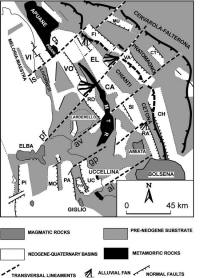|
Sedimentology (2007, in
press)
EFFECTS OF THE TRANSVERSE STRUCTURAL LINEAMENTS
ON NEOGENE - QUATERNARY BASINS OF TUSCANY (INNER NORTHERN APENNINES, ITALY)
ˇˇ
V. Pascucci1, I. P. Martini2, M. Sagri3
and F. Sandrelli4
ˇˇ
1Istituto
di Scienze Geologico-Mineralogiche, Universit¨¤ di Sassari, Italy
2Land
Resources Science, University of Guelph, Canada
3Dipartimento
di Scienze della Terra, Universit¨¤ di Firenze, Italy
4Dipartimento di Scienze della Terra, Universit¨¤ di
Siena, Italy
Several mountain arcs have formed in the Mediterranean area
during the Alpine orogeny, among them the Northern Apennines. They show
diachronous development with
 the
outer thrust front prograding eastward, and being progressively replaced to the
west by relatively thin, post-orogenic extensional or transtensional basins. The
outer and inner part of the orogen are linked together through a series of
transverse structural lineaments. Segments of such lineaments have through time
acted as transcurrent faults, lateral ramps of thrusts, strike- and oblique-slip
faults, and normal faults. In this paper we have synthesized a selection of the
main lines of evidence about transverse lineaments of the Northern Apennines,
and analyzed their effects on some Neogene-Quaternary basins of the inner part
of the orogen in Tuscany and northern Tyrrhenian Sea shelf. New information from
recently released commercial seismic profiles and from surface sedimentological
studies has made it possible to confirm that the post-orogenic basins formed in
tectonic depressions delimited by major, quiescent substrate thrusts. The
depressions were longitudinally separated into basins by the transverse
lineaments. The stratigraphy of the basins in each tectonic depression is
similar; in most cases, initial narrow syn- rift sedimentation was followed by
extensive post-rift successions due to thermal subsidence. However, the
thickness and distribution of their sedimentary sequences vary according to
different subsidence (or uplift) and extension that have occurred along each
side of the same transverse lineament, or in blocks delimited by different
lineaments. Furthermore, portions of the lineaments, such as of the
Livorno-Sillaro, may have temporarily acted as strike-slip faults (late
Miocene-Pliocene, in this case), and equivalent substrate highs and parts of the
same basin may have been shifted left-laterally for about 15-20 km. A further
effect of the transverse lineaments on basin sedimentation has been the
development of major alluvial fans at relay ramps developed near the
intersection of lineaments and quasi-orthogonal, listric boundary faults. the
outer thrust front prograding eastward, and being progressively replaced to the
west by relatively thin, post-orogenic extensional or transtensional basins. The
outer and inner part of the orogen are linked together through a series of
transverse structural lineaments. Segments of such lineaments have through time
acted as transcurrent faults, lateral ramps of thrusts, strike- and oblique-slip
faults, and normal faults. In this paper we have synthesized a selection of the
main lines of evidence about transverse lineaments of the Northern Apennines,
and analyzed their effects on some Neogene-Quaternary basins of the inner part
of the orogen in Tuscany and northern Tyrrhenian Sea shelf. New information from
recently released commercial seismic profiles and from surface sedimentological
studies has made it possible to confirm that the post-orogenic basins formed in
tectonic depressions delimited by major, quiescent substrate thrusts. The
depressions were longitudinally separated into basins by the transverse
lineaments. The stratigraphy of the basins in each tectonic depression is
similar; in most cases, initial narrow syn- rift sedimentation was followed by
extensive post-rift successions due to thermal subsidence. However, the
thickness and distribution of their sedimentary sequences vary according to
different subsidence (or uplift) and extension that have occurred along each
side of the same transverse lineament, or in blocks delimited by different
lineaments. Furthermore, portions of the lineaments, such as of the
Livorno-Sillaro, may have temporarily acted as strike-slip faults (late
Miocene-Pliocene, in this case), and equivalent substrate highs and parts of the
same basin may have been shifted left-laterally for about 15-20 km. A further
effect of the transverse lineaments on basin sedimentation has been the
development of major alluvial fans at relay ramps developed near the
intersection of lineaments and quasi-orthogonal, listric boundary faults.
|